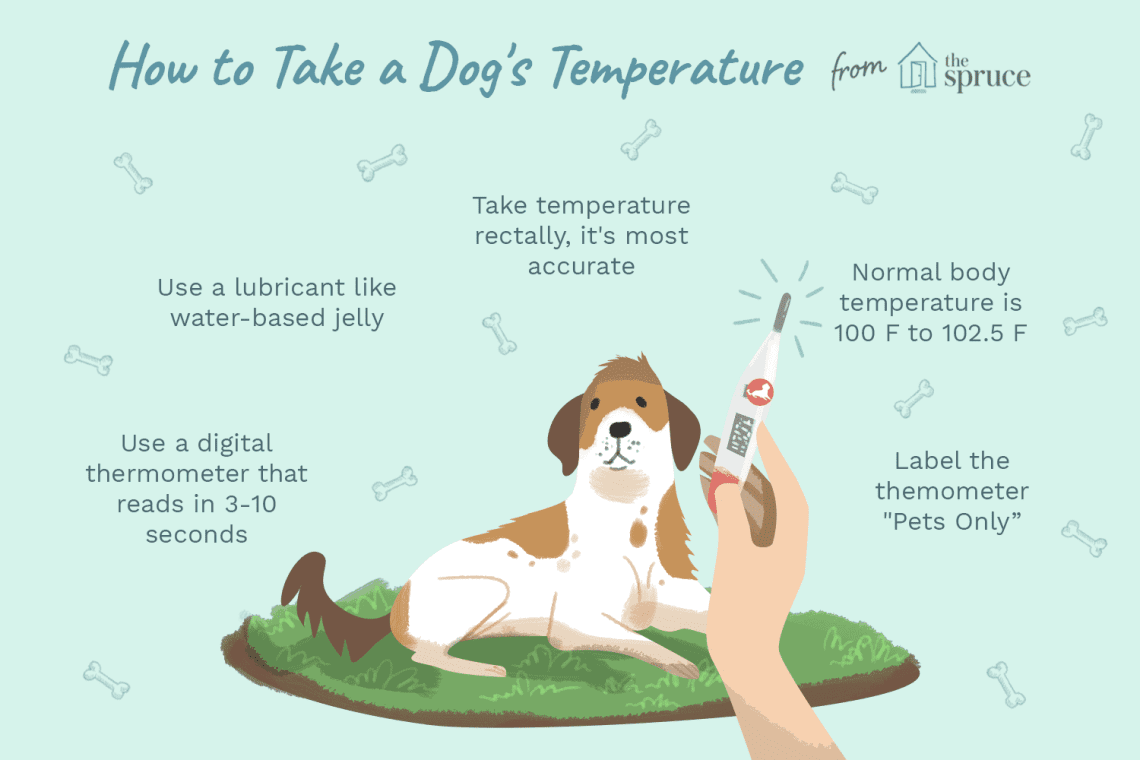
Normal body temperature in a dog: how to measure and what to do with high (low) rates
As in humans, in dogs, body temperature is the main sensor of the state of the body. So, its indicators more than the norm established for this animal can be a sign of illness. This is an occasion to immediately contact the veterinarian in order to avoid complications.
The owner of the dog must know how to properly measure the temperature of his four-legged friend.
Contents
Normal temperature in dogs
For young animals, unlike an adult dog, a higher temperature is characteristic – the norm for a puppy is 39–39,5 ° C. This is due to the immature system of thermoregulation, as well as many processes in a growing organism. It is also a kind of protection in case of a long absence of the main source of heat – the puppy’s mother.
In winter this high temperature will not let the baby freeze by cold. This temperature regime usually lasts until the pet is six months old. After that, the dog has a more perfect system of thermoregulation and its body temperature is set at 38,5 ° C. Permissible fluctuations in indicators can be within 37,5-39 ° C, they depend on the individual characteristics of each individual breed:
- hairless dogs have the same temperature as those that are covered with hair;
- short haired and hairless dogs experience overheating and hypothermia fasterthan their long-haired counterparts, hence the sharper fluctuations in their temperature;
- dwarf dog species have a higher temperature than large individuals, but in general this is a very small difference (0,5 ° C).
In order not to miss the onset of the disease, body temperature should be measured at least once a month, especially in the younger generation. So you will know the norms of your pet and will be able to easily navigate them even when the dog becomes an adult.
How to take a dog’s temperature?
It is most convenient to measure the temperature by placing the dog in a rack or laying it on its side. Choose a method that suits your pet, some dogs feel more confident standing up. Thermometer lubricated at the tip oil or vaseline, gently inserted into the anus to a certain depth:
- for small dogs by 1 cm (up to 20 kg);
- for large dogs by 1,5–2 cm.
After 5 minutes (for mercury) and the signal of an electronic thermometer, you will know the desired indicators.
It is best to talk affectionately with the dog during the procedure, scratch behind the ears, stroke soothingly. If everything is done correctly and without compulsion, then the dog will not notice that something was measured with a thermometer.
What thermometer to use? Best of all, of course, is electronic, since a mercury thermometer is very thin at the tip and can burst with a sharp movement, and this is highly undesirable.
If the dog is struggling, then it is better to postpone the procedure, calm him down and call a helper to keep the dog together. Please note that the thin tip of the thermometer can damage the intestines, so you need to try to keep the animal’s pelvis in a stationary position.
What to do with boundary indicators?
If you know for sure that you measured everything correctly and you are confused by the temperature indicator, then you need to figure it out. If we talk about the health of a puppy, then it can be assessed with the naked eye:
- eats well;
- sleeps sweetly;
- mobile and curious;
- good chair.
But an adult can sometimes become sad, become more apathetic for various reasons. And if at the same time you find even a slight deviation from the norm on a thermometer, then this may be the first call of a serious illness – a virus, a bacterial infection or worming. Need as much as possible visit the vet as soon as possiblebecause the course of some diseases is rapid.
Also, the temperature is slightly increased (by 1-1,5 ° C) in chronic and systemic diseases, as well as oncology. Do not be too scared, because even oncology is curable if you go to the doctor in time and diagnose the disease.
If we talk about systemic diseases that cause a constant slight increase (or decrease) in temperature in dogs, then this is the cardiovascular system, thyroid function, and hormonal disruptions. Low heat transfer is a wake-up call that may indicate internal bleeding, but it is also characteristic of hypothermia.
You can also note a slightly lower temperature after exhausting exercise, unusual for your pet. In its turn, overheating and lack of drinking in the heat may cause a slightly elevated temperature, which will return to normal when the animal returns to normal conditions. Severe stressful events also cause temperature fluctuations.
But if your dog is showing signs of a lethargic state, then a normal temperature cannot be an indication that all is well. It is always better to consult a veterinary clinic, maybe your concerns are just a quickly fixable simple problem.
High fever in dogs
What to do if you find your pet has a fever? Never do not use drastic cooling measures like a cold bath with ice or an ice shower. A sharp temperature drop can cause shock, vascular spasm up to a stroke and even a heart attack.
But antipyretic tablets should not be given to an animal unless they have been prescribed by a veterinarian. From more or less safe means, use nurofen or antipyretic suppositories. From emergency measures – make an injection of no-shpy or diphenhydramine with analgin (papaverine). All these are first aid drugs in a human first aid kit and they can all be harmful for dogs. In addition, bringing down the temperature is not always safe and it can worsen the course of the disease.
If the mark on the thermometer is below 40 ° C, then call the veterinarian and wait, if it is higher, immediately take the animal to the doctor. Here’s what the owner can do before the doctor arrives:
- give the dog water or a decoction of chamomile (raspberry leaves) at room temperature, but little by little;
- apply cooling wet compresses to the sides and back of the animal, changing them when the towel becomes warm;
- you can use ice by putting it in a bag and wrapping it with a rag. Apply such ice bags to the paws and the occiput;
- put bottles of cold water next to the dog, cover them with a towel. Your pet will most likely choose to lie down close to the cooling source.
The main thing is to often measure body heat indicators so as not to cool the animal that has already cooled down, and in case of ineffective measures, immediately contact the veterinarian. Some viruses are so fleeting that every minute counts.
Low temperature in dogs
As described earlier, a lower temperature can be caused by many factors. If this is a banal hypothermia, then warm your pet – warm water, warm compresses on the sides and back or a heating pad. But do not overheat the animal, for this constantly measure the temperature. To exclude serious systemic disorders, you need to show the dog to the veterinarian in the near future. At values below 37-36 ° C, this the visit must be urgentto avoid internal trauma and blood loss.







